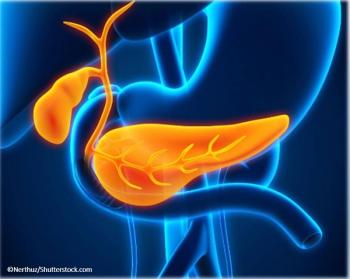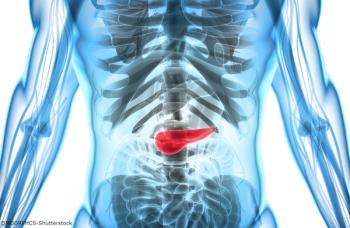
Phase 3 Study Explores Pamrevlumab for Unresectable LAPC
The first-in-class inhibitor of connective tissue growth factor activity is being explored in combination with neoadjuvant gemcitabine and nab-paclitaxel as a potential method for downgrading unresectable locally advanced pancreatic cancer.
Pamrevlumab is being explored in combination with neoadjuvant gemcitabine and nab-paclitaxel (Abraxane) in the phase 3 LAPIS trial as a potential method for downgrading unresectable locally advanced pancreatic cancer (LAPC).
The phase 3 trial (NCT03941093),1 which is currently enrolling, will randomize 256 patients to receive pamrevlumab, a first-in-class inhibitor of connective tissue growth factor (CTGF) activity, or placebo with the chemotherapy doublet prior to surgery. The dual primary end points are improvement in overall survival (OS) and the portion of patients achieving R0 or R1 resection.
“Patients with unresectable LAPC face a dire prognosis. The use of pamrevlumab, a novel antifibrotic used as neoadjuvant therapy, may change tumor status from unresectable to resectable, thus potentially improving the prognosis of the patient,” Pascal Hammel, MD, PhD, a gastroenterologist, oncologist, Hôpital Beaujon, Clichy France, said in a statement when the first patient was dosed in the trial in 2019. “If this pivotal phase 3 trial is successful, I believe this type of treatment will be highly valued by the physician community treating LAPC.”
In the phase 3 study, patients will be randomized 1:1 to receive up to 6 cycles of treatment. Intravenous pamrevlumab will be administered at 35 mg/kg on days 1, 8, and 15 for the first cycle and on day 1 and 15 of each subsequent cycle. Intravenous nab-paclitaxel and gemcitabine will be administered at standard doses (125 mg/m2 and 1000 mg/m2, respectively) on days 1, 8, and 15 of each 28-day cycle.
Following the 6-cycle neoadjuvant treatment, patients will be assessed with exploratory surgery for the possibility of achieving an R0 or R1 resection. If eligible, the surgery is required to occur between 4 weeks and 8 weeks following cycle 6, per the trial protocol. Samples from the surgery will be collected and analyzed for biomarkers and the secondary end points of the trial include progression-free survival (PFS), quality of life, and patient-reported outcomes.
The phase 3 study was preceded by intriguing phase 1/2 results, which were recently published in ESMO Open.2 In this study, patients with unresectable LAPC were randomized 2:1 to receive gemcitabine plus nab-paclitaxel with pamrevlumab (n = 24) or without (n = 13). The neoadjuvant treatment regimens were administered for 6 cycles and then surgical eligibility was assessed.
In this study, the PFS was 14.1 months (95% CI, 8.2-18.4) with the pamrevlumab, nab-paclitaxel, and gemcitabine combination, compared with 11.6 months for those receiving chemotherapy alone (95% CI, 3.9-19.0). Across all patients, whether eligible for surgery or not, the 1-year OS rate was 75% with pamrevlumab compared with 85% with chemotherapy alone. The median OS was 19.3 months with pamrevlumab versus 19.0 months without.
Distinct differences in survival were seen when exploring those who were downstaged and became eligible for surgery. Overall, 16% of patients were radiographically downstaged by National Comprehensive Cancer Network criteria, which included 5 in the pamrevlumab arm (21%) and 1 in the chemotherapy alone arm (8%).
In those eligible for surgical exploration, which included 17 patients treated with pamrevlumab versus just 2 with chemotherapy alone, the OS was 27.03 months (95% CI, 15-not reached), regardless of initial treatment. In those who were not eligible for exploratory surgery, which included 7 treated with pamrevlumab and 11 receiving chemotherapy alone, the OS was 18.4 months across patients (95% CI, 10.6-20.2).
The median OS for those who went on to receive resection was not reached, highlighting the importance of reaching resection for patients with LAPC. The resection group included 8 patients treated with pamrevlumab and just 1 patient who received chemotherapy alone. Those who were ineligible for resection (16 treated with pamrevlumab and 12 with chemotherapy alone) had a median OS of 18.56 months (95% CI, 13.2-20.2).
Overall, more patients completed 6 cycles of treatment in the pamrevlumab group versus chemotherapy alone (75% vs 54%, respectively). Toxicity patterns were similar between the 2 arms. Overall, serious adverse events were experienced by 38% of patients in the pamrevlumab arm compared with 46% for those receiving chemotherapy alone. The authors of the study did not note any increase in toxicity with the addition of pamrevlumab.
“We are grateful for the opportunity to build on supportive data from our previous phase 2 studies, as we continue to explore the potential of pamrevlumab as an important treatment option for patients with LAPC,” Elias Kouchakji, MD, senior vice president of clinical development, drug safety, and pharmacovigilance at Fibrogen, the company developing the drug, said in a statement in 2019. “We are excited to further advance late-stage development of pamrevlumab as a treatment for locally-advanced pancreatic cancer.”
In early 2018, the phase 2 data for pamrevlumab in combination with gemcitabine and nab-paclitaxel led to an FDA fast track designation for the treatment of patients with locally advanced, unresectable pancreatic cancer. The fast track designation is meant to accelerate the development, review, and approval of drugs that treat serious and life-threatening conditions. The phase 3 study, which continues to actively enroll, has a primarily completion date of September 2022.
References
- Evaluation of efficacy and safety of neoadjuvant treatment with pamrevlumab in combination with chemotherapy (gemcitabine and nab-paclitaxel) in locally advanced pancreatic cancer. ClinicalTrials.gov. Updated December 17, 2020. Accessed February 16, 2021. https://clinicaltrials.gov/ct2/show/NCT03941093
- Picozzi V, Alseid A, Winter J, et al. Gemcitabine/nab-paclitaxel with pamrevlumab: a novel drug combination and trial design for the treatment of locally advanced pancreatic cancer. ESMO Open. 2020;5(4):e000668. doi:10.1136/esmoopen-2019-000668
Newsletter
Stay up to date on recent advances in the multidisciplinary approach to cancer.


















































































